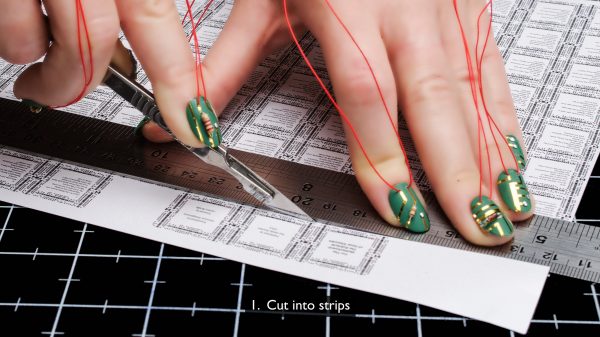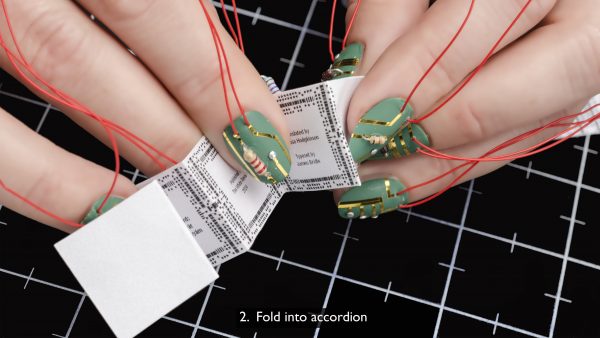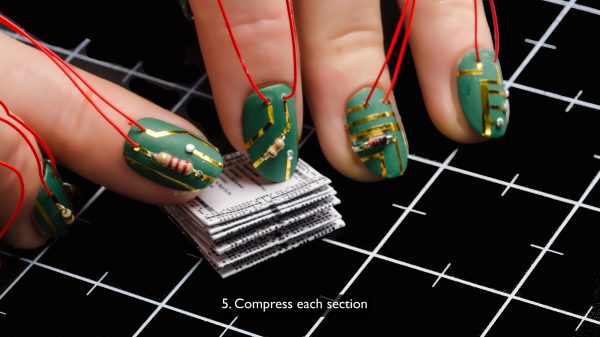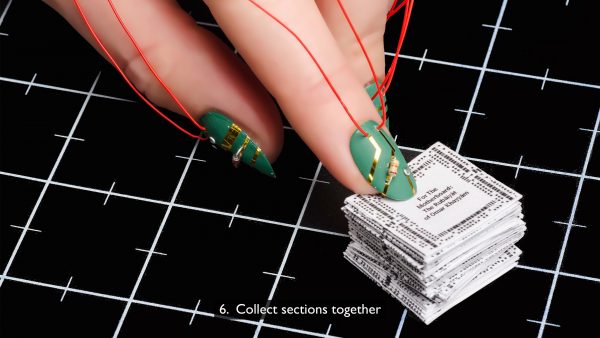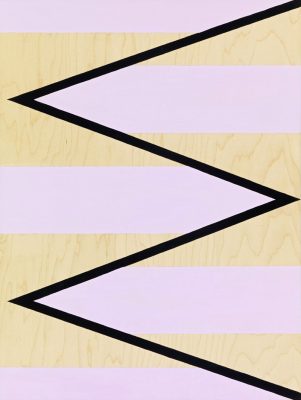Please click on the links below to download, print and assemble (instructions in slideshow above) Vanessa Hodgkinson’s For the Motherboard: The Rubáiyát of Omar Khayyám, typeset by James Bridle.
share
A Note on the Text
by Vanessa Hodgkinson
The Rubáiyát that I own is one given to me over a decade ago when I lived in Kuwait. A modest copy bound in plasticised leather, it is cheap but speaks of the sumptuousness of its genealogy. Of ‘travelling size’, it is like a bloated cheap postcard. Every verse is surrounded by a repeated border of flowers that have long since been abstracted beyond recognition of anything natural. The paper is sleek; a biro slides over it without leaving much more than an oily smudge.
This Rubáiyát is special to me because it is a dual translation of the original Persian verse into French and English. While I couldn’t appreciate the Persian, I was being given a double window of opportunity in both French and English, my maternal and paternal tongues. It acted as a playful reminder of my inability to master Arabic, let alone Persian, despite moving to Kuwait to do so.
I often compare my pidgin Arabic to my pidgin HTML. These languages intrigue me but I am locked out of their possibility. Despite my best intentions I am never going to master them. I recognise forms, sequences, ways in which they coagulate to have meaning. They both contain a fundamental logic that I admire and wish I could possess. What kind of person might I be if I did read and write in Arabic and was proficient in computer programming! We can only shudder at the thought. But the reality is that despite these languages being constantly on the edges of my everyday experience, I am, and perhaps choose to be, eluded by them.
The Rubáiyát of Omar Khayyam opened a door in the nineteenth century to a whole form of poetry not known to the masses of the West until it was translated and amalgamated by Edward FitzGerald in the late 1850s. FitzGerald’s linguistic tenacity was evidently more determined than my own. It arrived just in time to be met by an audience opening itself to the possibility of a world critical of God’s intentions for them, gunning for the spirit of individuality and a whole lot of carpe diem. It happened to be published in the very same year as Charles Darwin’s Origin of the Species, 1851.
To a modern reader, the Rubáiyát reeks of everything Edward Said couldn’t stand: languor, hedonism, a vaguely academically underwritten Orientalist rambling. But in reality it is a selection of poems by the renowned polymath Omar Qayyam, written in the early twelfth century, originally in Persian. A ruba’i is a two-line stanza with two hemistichs per line, and so the word Rubáiyát, tied to the Arabic root for the number four (ra, ba, ya), means ‘quatrains’. These short poems deal with universal themes of life, death, love and religion, and come from the breadth of Khayyam’s knowledge, bridging his worlds of algebra and philosophy through poetry. The act of making these subjects legible and attractive to a western audience is not only the value of Khayyam’s original verse but also Fitzgerald’s interpretation of them. As Marina Warner suggests (LRB, 9 April 2009), FitzGerald had a deep knowledge of the Greek, Latin and English poets before taking on Persian verse, and if the Rubáiyát ‘reads as if its lines have always existed, this is an effect of the echo chamber of FitzGerald’s mind’. He chose from over a thousand poetic fragments and brought them into a ‘whole’ that had its own internal arc, one never prescribed by Khayyam.
That translation process didn’t stop with FitzGerald, but has gone through dozens of interpretations and re-presentations since 1851, as if it posed a challenge to every discerning scholar-cum-poet of his or her age. Versions exist in Russian, Hindi, Japanese, Galician, Serbo-Croatian, Vietnamese, Swahili, Welsh, Hungarian and Finnish, to name but a few permutations. There are forty-eight Chinese translations alone. The Rubáiyát is one of the best-known poems in the world.
But how did these hundred or so quatrains make their way into, and so steadfastly remain in, the popular consciousness? The answer lies not only in its content, which evidently speaks to humanity across almost every possible divide, but in its very form.
In the early twentieth century, when the popularity of the Rubáiyát was at its height, the most easily affordable of its many versions was also one of its most portable: the miniature book.
The Miniature Book Society describes its objet d’amour as one whose height and width do not exceed 7.5 cm. Whilst this diminutive form had been present for many centuries alongside more standard sizes of religious texts, the miniature form became most popular in the nineteenth century. Miniature religious texts and books of devotion were not only more portable, but allowed the believer to carry and use them whenever the occasion arose. The Bible, Koran and Buddhist Sutras all have a rich history of being made as small as humanly possible, posing a challenge of a spiritual order both to the maker of the volume and to its reader.
However this form also allowed for easy concealment in times when carrying a book containing such sensitive subject matter might have caused problems. The first manual on birth control published in the United States, Charles Knowlton’s Fruits of Philosophy, or The Private Companion for Young Married People (1832) was a handily pocket-sized 7 cm. But making it so small didn’t help Knowlton much when he was imprisoned and fined for his corrupting tract.
Bound in Moroccan leather with gilt edges, woodcuts and engravings in many editions, the miniature could be a prized and expensive object to own. It could also be produced for a fraction of the price and be sold for a penny, and this was the way in which the Rubáiyát was disseminated to many in the late nineteenth and early twentieth centuries. It was carried by many soldiers during the First World War. A small collection of poetry that dealt with life and death in the way that Khayyam did was to bring succor to many a soldier on the front line of battle.
In the October 1915 edition (no. 9) of In Ruhleben Camp, a magazine produced by the detainees of the internment camp (including many British men of the Allied Forces), twelve quatrains parodying the Rubáiyát were published as ‘Translated from the original by S.E.J.’ under the title ‘Omar Khayyam at Ruhleben’.
Wake! For the Glories of the Rising Sun
Remind us of another day begun.
There is the old routine to live again,
The weary round before the Day is done…
A wonderous, motley crowd are we, and queer,
Made more so, possibly, in the long year
Of tedious Trivialities and Talk,
Sans Wine, sans Cash, sans Women, and Sans Beer. …..
How do we experience miniaturisation today? The miniature book is a distant memory, preserved by collectors and societies that meet annually in mid-west American hotels. But much of the experience of that language of the teeny tiny has come down to us through the condensing of information and technologies into ever smaller casings.
How many of us have read an article on our smartphones in a font size much smaller than this that you are dealing with now? Our eyes squint to take in the ingredients lists on the sides of food packages, the small print on non-transferable, too-expensive train tickets, the disclaimer for another app update we click on to keep our social media wheels turning smoothly. We deal with miniature texts every day.
A Note on the Type
by James Bridle
There’s a marvellous lecture by Tim Berners-Lee (‘How the world wide web just happened’) in which he talks about how he came to create what turned out to be the world wide web. He describes growing up as the child of Computer Scientist parents who had worked at Bletchley Park, and building his first circuits from bits of wire, wrapped around nails, hammered into a piece of wood. Once he’d got the hang of that, he was just in time for the invention of the transistor, and then the integrated circuit. As the components available to him got ever smaller, the complexity of the machines they could power increased exponentially. As Berners-Lee tells it – with some modesty – it was a simple, natural progression from crystal radio, to building his own computer, to putting in place the fundamental transfer protocol that most of us use to access the internet. As things shrank, they also became more powerful, more networked, leading inevitably to an almost total, sublime connectivity.
Another version of this story starts with Harry Reed, one of the mathematicians who worked on the very first electronic, general-purpose computer, the ENIAC, in the 1940s. The ENIAC was a vast machine, occupying several rooms in the engineering department of the University of Pennsylvania. As it worked away on its calculations, it was possible to follow the actual shape of these deliberations across the walls, with lights blinking on and off as various circuits flared into life and faded out again. As Reed beautifully observed, in a lecture entitled My Life with the ENIAC: A Worm’s Eye View, ‘The ENIAC itself was a strangely personal computer. Now we think of a personal computer as one which you carry around with you. The ENIAC was one that you kind of lived inside.’
The ENIAC is almost impossible to compare to a modern computer because it didn’t have any transistors at all, just racks and racks of vacuum tubes. Suffice to say that in 1996, students at the University of Pennsylvania created an ‘ENIAC-on-a-chip’ – a chip the size of a fingernail – that replicated all of the functions on the original thirty ton machine, and this was already a trivial accomplishment. The architectures are incomparable, like saying your iPhone is more powerful than NASA’s entire moon-launching cluster. Hell, a 1981 IBM PC was more powerful than the Apollo Guidance Computer. What strikes one viscerally is the size difference. The computer which Reed lived inside is now tiny, but also everywhere.
What underlies these narratives is an observation common across all computing hardware. Known as Moore’s Law, it was formulated in 1965 by Gordon E Moore, co-founder of Intel, and it states that the number of transistors in an integrated circuit doubles approximately every two years. The practical effect of this is that computing power increases exponentially, as not only the number of transistors in space increases, but so does their efficiency. (In a very real sense, Moore’s Law is also a self-fulfilling prophecy, as it is used to set targets and research goals for the semiconductor industry. As above, so below: most of what is possible with computers now is the result of architectural decisions made decades ago.)
A corresponding law for data storage is known as Kryder’s Law, and its graph is a lot steeper than Moore’s. This is due to the fact that storage is not just a factor of physical bit size, but also of compression algorithms and error-correction codes, which ensure the veracity of data as well as its viability. Maths and materials leap-frog one another; like books themselves, comprehension is a composite of information and understanding. The content must be reanimated in the mind.
This book, For the Motherboard: The Rubáiyát of Omar Khayyám, takes into account some of the limitations of working at scale across digital devices. The first of these is the display size: in an era of ‘retina screens’, where the pixel density of our displays begins to surpass in definition the clusters of rods and cones in the human eye, we are still limited in print by the apertures of our ink nozzles. This is not a new problem: For the Motherboard… is set in Bell Centennial, a font commissioned by AT&T from the designer Matthew Carter in 1975, to replace Bell Gothic, which it had been using in its phone directories since 1938. Between those years, the number of telephones in the United States alone grew from some twenty million to around 140 million. Carter’s Bell Centennial typeface exists because of explosive, networked growth, addressing both this increased technological density, by condensing the character width, and the limitations of contemporary printing, by adding ‘ink traps’ to the letters, minute nicks in the letterforms to absorb and counter the ink spread caused by rapid printing on newsprint. When printed at sufficient size on coated paper, these traps remain visible, tiny reminders of previous technological limitations.
The second problem is variability: as the printing press of old is now distributed across the world’s desktops and office spaces, an immense variety of formats opens up to us, from which we have selected two: US Letter and A4. The former is by far the most common across the Americas, its origin apparently lost – although the American Forest and Paper Service relates it, beautifully, to a quarter of ‘the length of the vatman’s arms’, from the days when paper was handmade by soaking rags in moulds. The more prosaic, world-wide (but Euro-originated) A standard is based, enlightenedly, on a single aspect ration of the square root of 2, approximately 1:1.4142. On such calculations are standardisations built: the A0 sheet has an area of one metre squared (with the metre itself originally based on the circumference of the earth). Successive, ever-smaller sizes are defined by folding the sheet across the larger dimension: A1 is half an A0, A2 half an A1 and so on and so forth.
In Flann O’Brien’s The Third Policeman, the narrator describes with increased horror the procession of ever smaller, identical hand-made chests produced by Sergeant MacCruiskeen, one from out of the last. He begins with this hands, grasps the third with butter-spades, the next with teaspoons, then ‘knives, small knives and smaller knives’, the last few with a pin, and then with some tool the narrator cannot, or cannot bear, to see. Thirty-one in total are finally arrayed, but barely. ‘I have made another different one every year since with any amount of nightwork and overtime and piece-work and time-and-a-half incidentally. Six years ago they began to get invisible,’ says the Sergeant.
Likewise, it is possible to imagine an infinite succession of paper foldings (of which the page size of For the Motherboard… would be approximately A10) down to the micron level, which would occur around A24. Only twenty four folds – fewer than MacCruiskeen’s machinations – but an almost ungraspable distance. At such depths is computation performed.
In The Hitchhiker’s Guide to the Galaxy, Douglas Adams wrote that ‘Space is big. You just won’t believe how vastly, hugely, mind- bogglingly big it is. I mean, you may think it’s a long way down the road to the chemist’s, but that’s just peanuts to space.’ What is equally difficult to grasp is how small space is, how intricately enfolded it can become, how our minds, conditioned to think at the scale of our bodies and our physical surroundings, cannot begin to cope with operations which take place below the size of hairs, and teeth, and cells, let alone those which occur in other spectra and forms of matter, from the outer reaches of the electromagnetic to the quantum aspect of one-dimensional strings.
The divine is often figured as vast, awesome, overarching and formidable. But it can also be considered in the minute, the indistinguishable, the underlying, and the incomprehensible. What the history of technology shows us – because technology is not, as many seem to think, merely a tool with which to shape the world, but a lesson we teach ourselves about how it truly is – is that that which is smaller is more connected, inherently networked, from the pages of the miniature book to the microchips and laser lights which make up the global telecommunications system. Everything wants to be networked, to be disseminable, to be communicated. It wants to shrink, to get inside and out: it demands it. It wants to connect.
Nails by Alice Bartlett
Photography by Richard Valencia
share
ABOUT THE CONTRIBUTOR
Vanessa Hodgkinson
is an artist and currently a participant at the Jan Van Eyck Academie in Maastricht. www.vanessahodgkinson.comJames Bridle
is a writer, artist and publisher based in London, UK. His work can be found at http://booktwo.org/.READ NEXT
